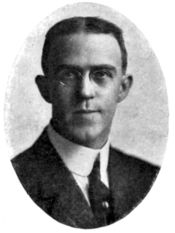William Leslie Welton
William Leslie Welton (born in Nebraska) was an architect active in Birmingham during its boom years at the beginning of the 20th century. Welton came to Birmingham in 1907 from the New York firm of McKim, Meade & White. Prior to that he had trained at the Massachusetts Institute of Technology under Constant-Désiré Despradelles, and in Europe as the 1900 recipient of the Rotch Travelling Scholarship to the École des Beaux-Arts in Paris. He also received special training at the Boston Society of Architects and Boston Architectural Club.
He started his practice here in partnership with native Alabamian and fellow McKim, Meade & White alumnus William T. Warren. They practiced together as Warren and Welton, with notable commissions including the Empire Building (1909), Boy's Industrial School, and Chamber of Commerce Building. It has been speculated that the Empire Building was actually the design of J. E. R. Carpenter of the New York firm of Carpenter and Blair, with the two young architects coordinating construction on site.1.
After leaving his partnership with Warren in 1910, Welton established his own offices in the Empire Building. Early on he developed a specialty in interior decoration. Notable examples of his early solo work include the store and café for J. R. Brown in the Empire Building, the Stanford Store, and the residences of Mrs David Roberts and J. C. Maben.
His later projects grew in stature. He collaborated with New York's Mowbray & Uffinger on the completion of the John A. Hand Building and designed the circular Roman-temple styled Vestavia estate of former mayor George Ward, which became a signature landmark of the Birmingham area.
Works
- House prototypes for Corey (1910)
- John A. Hand Building (1912)
- Tutwiler Hotel (1914)
- Massey Building (1925)
- Jackson Building
- Rialto Theatre (1915)
- Vestavia estate (1925)
- BEBCO Building (1926)
References
- Alexander, James Rodger. (1986) Terra Cotta Facades of Birmingham Architecture. Exhibition catalog. Birmingham: UAB Visual Arts Gallery.
- American Illustrating Company (c. 1911) Pen and Sunlight Sketches of Greater Birmingham. Birmingham. p. 156
- Satterfield, Carolyn Green. (1976) Historic Sites of Jefferson County, Alabama. Prepared for the Jefferson County Historical Commission. Birmingham: Gray Printing Co.
